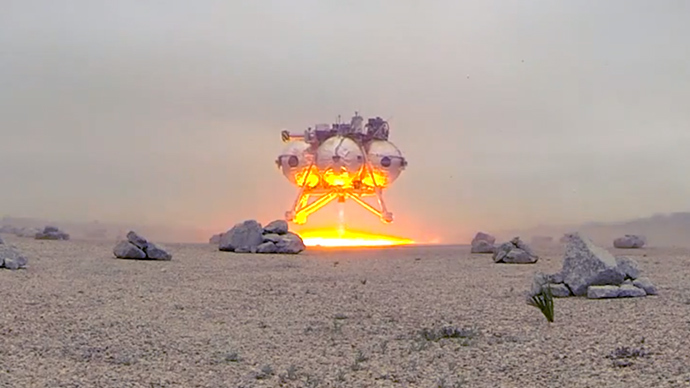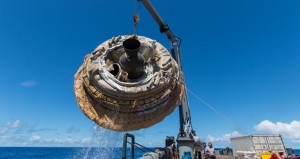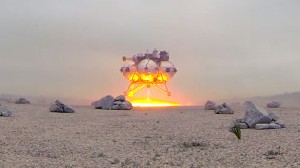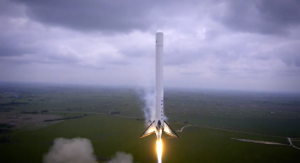June 30, 2014 – Over the weekend NASA test flew its Low-Density Supersonic Decelerator (LDSD) near the Hawaiian Islands. It is NASA’s solution for landing heavier payloads on the surface of Mars and the test produced “nominal” results. Nominal is NASA jargon for “as expected.” The LDSD plucked from the Pacific appears in the image below.
Referred to as NASA’s flying saucer, the LDSD is an inflatable balloon-like heat shield ring that deploys as a spacecraft descends during entry into a thin atmosphere like that on Mars. Increased drag safely decelerates the payload from spaceflight speeds to a more modest Mach 2.5 (around 3,000 kilometers or 1,900 miles per hour). LDSD is designed more for decelerating payloads with no humans on board. It could be used to deploy a surface habitat with Martian human crews arriving later using a different mode of controlled descent.
That’s where Project Morpheus fits in. Morpheus is a vertical takeoff and landing technology designed to provide advanced controlled flight operations for crewed spacecraft sent to the Moon, an asteroid or Mars. The technology integrates advanced autonomous guidance systems with reusable rocket engines. It has recently successfully been tested a number of times and can alter its trajectory based on visualizing ground-based obstacles. You can see the Morpheus prototype in descent mode in the photograph appearing below.
In combination with the LDSD, Morpheus brings humanity much closer to a solution for safe flight to a place like Mars. Of course the interplanetary transit challenges remain. But at least the descent and landing technologies appear to becoming viable.
But Morpheus isn’t the only kid on the block perfecting controlled landing technology. SpaceX, the commercial space launch company, has been experimenting with its own reusable launch technology. In previous postings I have described the Grasshopper program, SpaceX’s initial experiments in controlled ascent and descent using a booster first stage rocket. More recently the company demonstrated in the launch of a Falcon 9 Dragon resupply mission to the International Space Station (ISS) controlled descent designed to bring a first stage through re-entry into the atmosphere in a controlled manner.
SpaceX has given the Falcon 9 new abilities. It fires all nine Merlin rocket engines on ascent. But when it reaches an altitude of 80 kilometers (50 miles), it shuts the engines down for stage separation. As the first stage separates and begins to fall back to Earth, three engines are relit to control re-entry. As the first stage booster further descends the three engines shut down and a single rocket engine is used to maintain final controlled descent. In the most recent flight the Falcon 9 accomplished a soft splashdown in the Atlantic Ocean off the Florida coast. But SpaceX in future payload resupply missions to the ISS intends to return its first stage to the launch site for touch down.
SpaceX in addition to nine more contracted NASA resupply missions, has a number of commercial customer satellite launches in 2014. With one or more of these flights it intends to recover the first stage boosters for rapid turnaround and relaunch, creating an operation similar to how commercial aircraft operate today.
SpaceX sees the technology it is developing for controlled descent here on Earth to be applicable for use in visits to other locations in the Solar System. It’s founder, Elon Musk, has the goal of getting to Mars sometime during the 2020s, a good decade before NASA.
Are NASA and SpaceX the only players working on controlled descent technologies? No. Here are some others looking at developing similar capability.
Blue Origin, another commercial space company, has been quietly working on vertical takeoff and landing rocket systems. Back in December it demonstrated the BE-3 liquid hydrogen rocket engine which is capable of multiple starts and variable thrust for use in controlled descents.
What about Russia, China, the European Space Agency (ESA) and JAXA, Japan’s national space program?
Russia’s Soyuz capsules today land on the ground. They do this using a combination of parachutes and landing engines during the touch down phase. But the Soyuz rockets fire a mere second before landing to cushion what is a pretty hard landing. The descent capsule is equipped with customized seat liners that serve to further ease the landing impact. But Soyuz is not reusable. And Russia appears to have nothing in the works today to give them powered descent for a human-crewed mission to Mars.
China, in its recent Chang’e-3 mission to the Moon demonstrated powered descent technology in delivering a robot lander along with a small rover to the lunar surface. This is technology equivalent to that which Russia and NASA perfected in the late 20th century. And although China has expressed ambitions to land a rover on Mars no later than 2020, the technology it will perfect for such a mission will be designed for small payloads. They are several decades behind both NASA and SpaceX.
ESA in its ExoMars Program is developing alternative descent and landing systems. But the ESA technology resembles that used by NASA in previous Martian landers. ESA is using aeroshell braking, and parachutes for final descent. But ESA has another trick up its sleeve. It has invested in Reaction Engines Limited, developers of the Skylon Space Plane, a fully reusable launch technology scheduled for first test flight in 2019. Skylon isn’t designed to cross from the Earth to the Moon. Its capability will be confined to satellite and human crew delivery in low-Earth orbit. But it is the closest form factor to a Buck Rogers rocket as illustrated below. The Skylon is on the left, the Buck Rogers rocket is on the right.
Is JAXA in the running? As yet the Japanese have done no more than develop parachute-controlled descent.
What about others? Virgin Galactic has a hybrid launch system that soon may be delivering small satellite payloads to orbit. But Virgin isn’t designed to travel to the Moon or Mars.
So that pretty much leaves the field to two contenders — NASA and SpaceX. And looking at how each does development, I place my bet on SpaceX to be the first to succeed in deploying a tested, reliable technology.






















